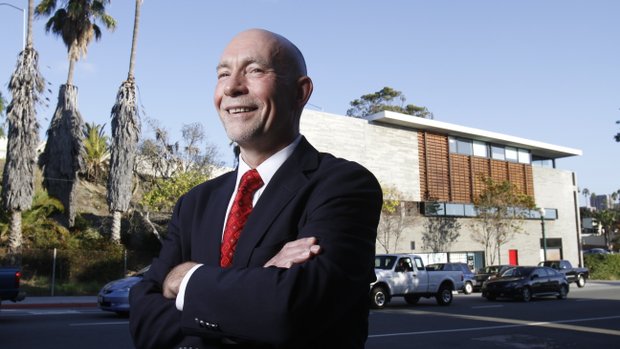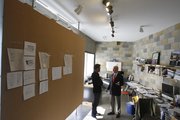BUSINESS GROWTH & DEVELOPMENT
How architects see the economy, what's ahead for SD City tours, professional development top priorities By Roger Showley7 P.M.JAN. 6, 2013

Bastiaan Bouma, new head of the local American Institute of Architects chapter, chose architect Lloyd Russell's R3 project in Little Italy as his new favorite building in San Diego. — John Gastaldo
Executive director and CEO, San Diego chapter of the American Institute of Architects

Born: July 10, 1952, Vancouver, B.C.; married, no children.
Education: University of Toronto; Osgood Hall Law School at York University, Toronto
Career: Trade commissioner and senior director for international trade and Canadian Tourism Commission in Indonesia, Turkey, San Diego and Detroit; vice president and managing director at the Chicago Architectural Foundation; director of global affairs fro the Society of Exploration Geophysicists in Tulsa, Okla.
Current book: "State of Wonder by Ann Patchett
Movie last seen in a theater: "Skyfall"
Favorite music: Jazz
Favorite food: Indonesian
Hobbies: Playing squash, gardening
On his new job: "It's a completely unpredictable career. In a way I am anticipating today's model of the agency economy. You have a kit of skills that are pretty transferable across sectors. I really did discover my true interests when I went to the (Chicago) architectural foundation, which combined tourism, culture, business management and an international perspective."
Bastiaan Bouma, 60, has set up trade missions in China and Brazil, overseen tours in Chicago and promoted oil and gas development for a trade group in Oklahoma.
So what's he doing in San Diego leading the local chapter of the American Institute of Architects?
The Canadian-born son of Dutch immigrants and husband of a fan of modernist design spent 1989-90 here cementing links between San Diego and Canadian biotech researchers and companies.
When given a chance to return, he saw the opportunities not only professionally but personally.
He met for breakfast at the Hob Nob restaurant in Bankers Hill to talk about his background and hopes for San Diego and its 1,800 licensed architects. Here are some excerpts:
Q: What did architects want for Christmas?
A: Like most of us, they're keeping their fingers crossed for a robust economy. (The improving housing market's) got to be good news for architects and designers and developers.
Q: What's going to happen to the economy in the coming year for architects?
A: I don't think there's any question that we're on the road to recovery. You see this nationally. The inventory of distressed properties is being reduced. I'm very optimistic about California generally. It's among the youngest states in the Union. The state has made major steps in key areas that I think will work very well for economic performance in coming years.
Q: You've taken over the chapter after years of a low profile.
A: They're hoping the chapter can become a recognized voice in the community to support broad public debate on development, sustainability, design, and that the expertise vested in our membership, our individual members, can be more fully engaged in the community and bring their expertise to the debate in planning and architecture.
Q: What ideas do you have to raise the chapter's profile?
A: I'd love to establish a speakers bureau and identify people that are coherent and comfortable enough in groups to be on call when get a call from a local community group when they need somebody to speak on the topic of design or sustainability or the latest building technologies.
Q: What do architects get out of such a program?
A: What I'm trying to underline for the architects is you can't just sit in your office and expect business to come in. You need to go out and promote yourself. You've got to be out there engaging with the audiences that are your potential customers.
Q: Throughout San Diego history, architects have regularly been leaders in many civic causes.
A: They need to shift their perspective a little and understand that public engagement is almost as big a part of their professional lives as doing good design. Unless they're able to communicate this effectively and engage with audiences or constituencies, they're not going to be successful. If they want to be more successful and sustain success over time, they can only do this with a public engagement strategy.
Q: What are some of your priorities for 2013?
A: We have two core areas. In continuing education (required for architects to retain their licenses), we'd like to offer a larger number of higher-quality programs in this area. The other area where would like to do a better job is to offer programs of broader interest to the general public. They're not insider, they're more accessible, they're less technical, less jargon-laden, and are addressing issues of concern to the residents of the county.
Q: What are some of the topics that you address?
A: There are clear environmental areas in design and sustainability. Infill projects -- how to effectively integrate new construction into established neighborhoods without alienating your neighbors and being seen as a constructive addition to the community.
Q: Do you offer forums, series, classes?
A: You want to make these things accessible and active in the communities as well. So we look for opportunities for people to engage with professionals in a nonconfrontational way on topics of interest and host them in the communities. We want to see topics and venues that would resonate with the broader public audience. Part of that is to re-elevate the chapter and its members in the minds of the public -- that we are experts in these areas and we have things to bring. It's not like we're dictatorial, but we feel we can contribute to the debate and the dialog in an informed and educated way and help enhance the strategic development of the community group.
Q: What will the AIA do about hot political topics of the day?
A: I think there's a concern that we not be seen as controversial. As a professional organization, we have a diverse membership that has diverse opinions. So my sense is we'd rather be out in front of issues, setting broad values rather than coming in at the back end of it when people's positions have been established and there's controversy and you're sort of forced to pick one of two options.
Q: In Chicago, you had an architecture store and various tour programs. Are those possible in San Diego?
A: San Diego gets 30 million tourists a year -- some fraction of that is business travel. Leisure visitors might be 10- to 12 million a year. They're perfect customers for cultural and tourism experience. So I think a shop would include a tour center and interpretive experiences on either foot or bus, Segway, boats or some combination, that are focused on the city's architectural and design legacy.
Q: Would only architects lead these tours?
A: It's mainly not architects. It's frustrated architects or teachers or engineers. Many of the docents we were recruiting (in Chicago) were in transition. Maybe 20 percent were younger, but many were 45 or 50, who might have just moved to the city or were divorced or retired. So they're were looking for a community of like-minded people and had a little bit of ham in them.
Q: What other programs could be imported from Chicago?
A: One major effort was Open House Chicago. The concept is a weekend of free public behind-the-scenes access to great places and spaces in Chicago. In Chicago in October there were more than 40,000 participants in a quarter-million site visits to more nearly 200 different buildings, citywide, in 25 community areas. It was a great way to mix it up and get people to visit places with which they were unfamiliar. I'm very interested in fostering something like this here,too.
Q: Now that you're back in San Diego, what do you like about it?
A: There's a certain relaxed life here I'm starting to recognize again. I just came from Chicago which is a pretty hard-driving city, and I'm discovering I need to dial down a little of my intensity here and take a more measured approach to my conversations and relationships. Instead of a day full of tense aggressive driving, I'm finding it easier to adopt a more languid approach to my relationships and conversations.
Q: When people realize your background in trade and economic development around the world, you'll surely be asked for your advice for San Diego.
A: I think San Diego is poised to be a gateway for that and let's keep our fingers crossed that things get resolved far as (Mexico's) internal problems are concerned. And the city could play a key role in California's renaissance as we emerge from the current economic struggle.
Q: What else do you observe about San Diego?
A: I have a very strong bias in terms of immigration and the value of immigration to economic growth and development. Immigrants bring a lot to the table. They're strivers. They're looking to improve themselves. They come for a reason and typically that's economic opportunity and professional opportunity. They're linked, and to me, continuing to make San Diego an immigrant-friendly place, a place that embraces new people, new cultures, new values, and to be a pivot point in supporting economic growth and development -- i think that's a key to success in San Diego.
Q: And the climate doesn't hurt in attracting newcomers.
A: I don't want to be simplistic and say it's climate. In my experience the climate quickly gets taken for granted.
Source: http://www.utsandiego.com/news/2013/Jan/06/new-aia-director-sees-improving-economy-architectu/









